This document provides an overview of Python data structures, specifically lists. It defines data structures as ways of storing data to make operations more efficient. It describes built-in and user-defined data structures, and focuses on lists as a general Python data structure that allows ordered sequences of mixed data types. Key characteristics of lists include mutability, indexing, slicing, and built-in methods for sorting, appending, and other operations. The document contrasts lists with the immutable string data type.

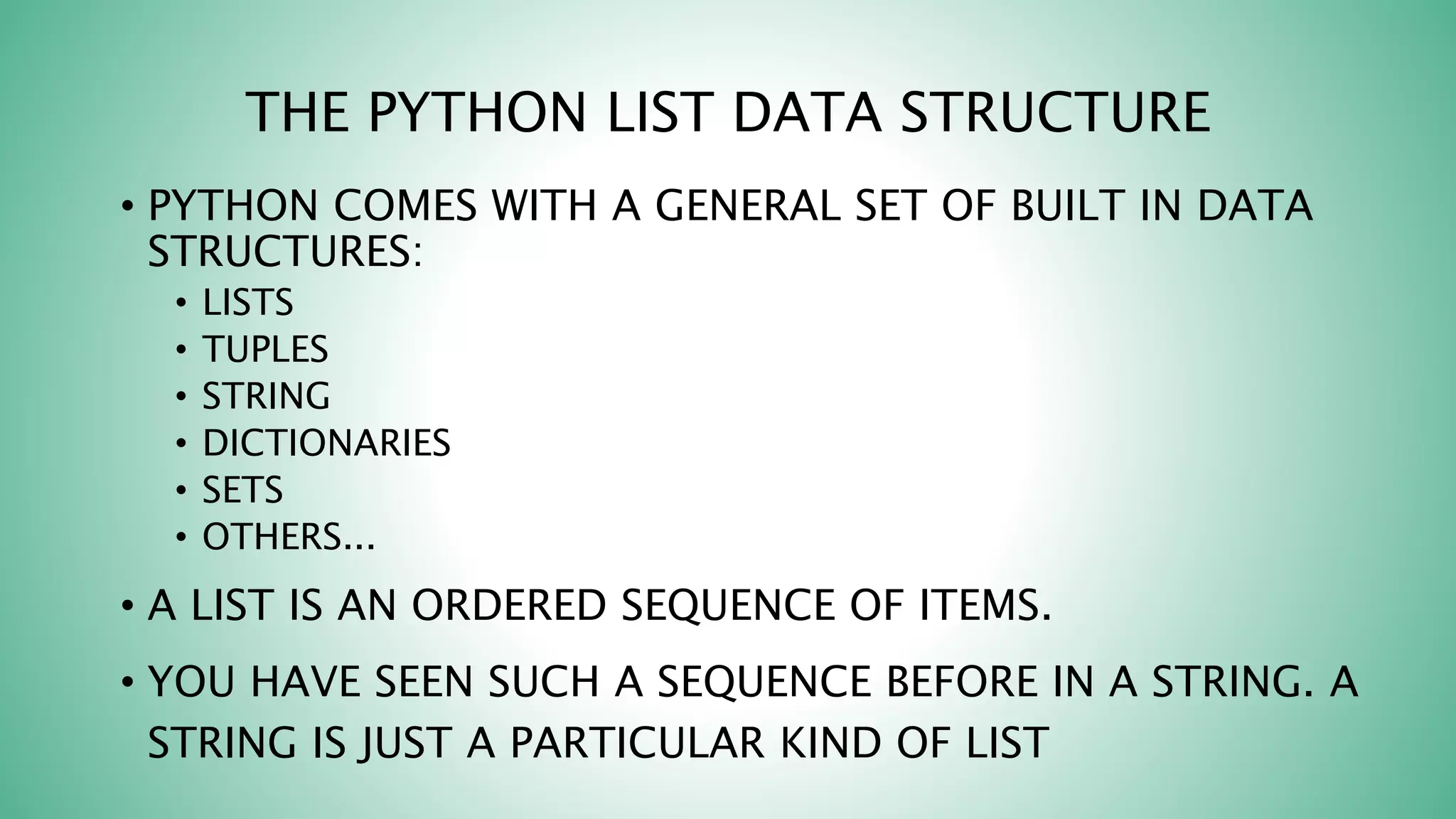
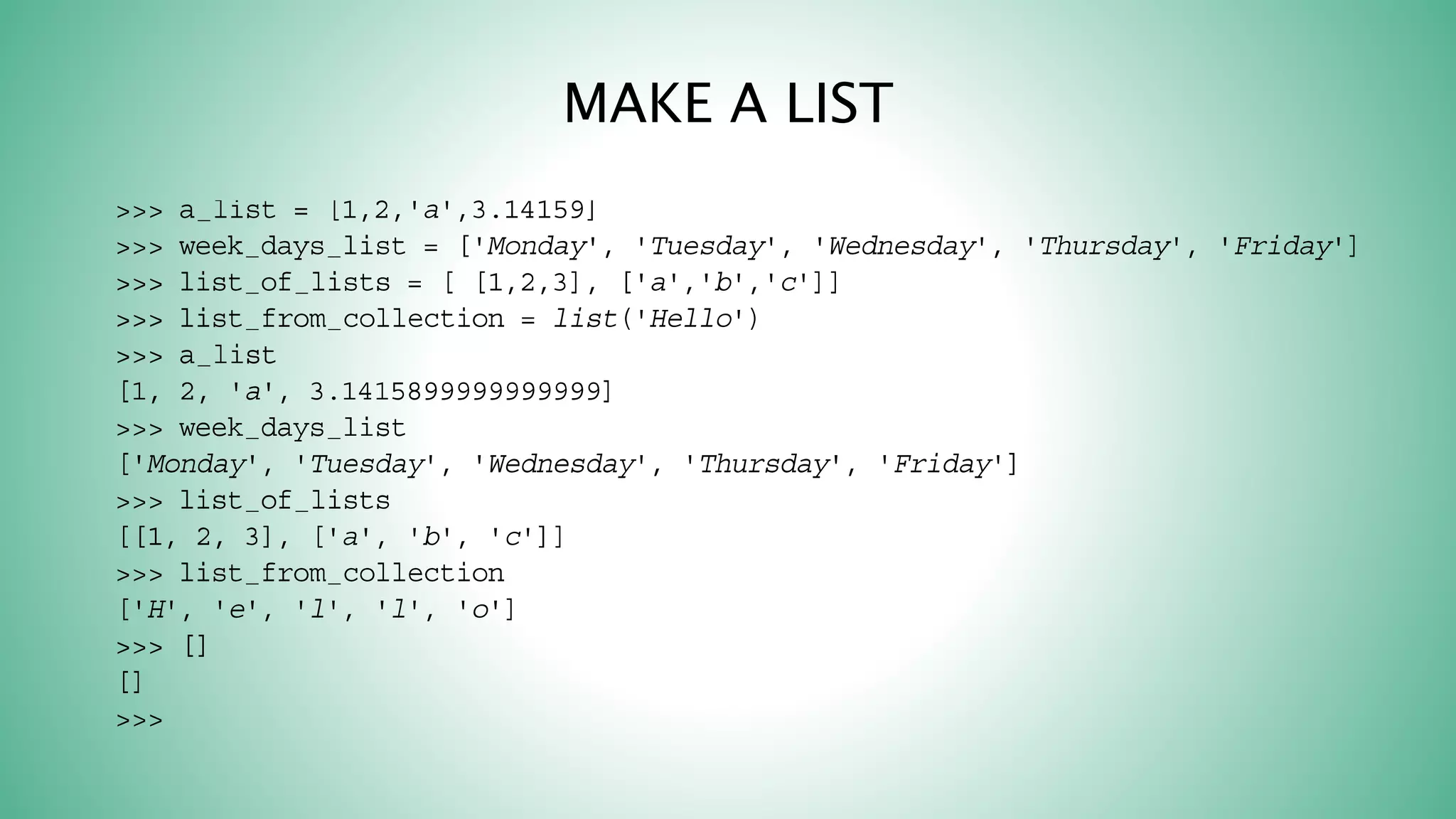
![SIMILARITIES WITH STRINGS
• CONCATENATE/+ (BUT ONLY OF LISTS)
• REPEAT/*
• INDEXING (THE [ ] OPERATOR)
• SLICING ([:])
• MEMBERSHIP (THE IN OPERATOR)
• LEN (THE LENGTH OPERATOR)](https://image.slidesharecdn.com/chapter7-210613212916/75/Lists-and-Tuples-4-2048.jpg)
![OPERATORS
[1, 2, 3] + [4] [1, 2, 3, 4]
[1, 2, 3] * 2 [1, 2, 3, 1, 2, 3]
1 IN [1, 2, 3] TRUE
[1, 2, 3] < [1, 2, 4] TRUE
COMPARE INDEX TO INDEX, FIRST DIFFERENCE DETERMINES THE
RESULT](https://image.slidesharecdn.com/chapter7-210613212916/75/Lists-and-Tuples-5-2048.jpg)
![DIFFERENCES BETWEEN LISTS AND
STRINGS
• LISTS CAN CONTAIN A MIXTURE OF
ANY PYTHON OBJECT, STRINGS CAN
ONLY HOLD CHARACTERS
• 1,"BILL",1.2345, TRUE
• LISTS ARE MUTABLE, THEIR VALUES
CAN BE CHANGED, WHILE STRINGS
ARE IMMUTABLE
• LISTS ARE DESIGNATED WITH [ ],
WITH ELEMENTS SEPARATED BY
COMMAS, STRINGS USE " " OR ' '](https://image.slidesharecdn.com/chapter7-210613212916/75/Lists-and-Tuples-6-2048.jpg)
![INDEXING
• CAN BE A LITTLE CONFUSING, WHAT DOES THE [ ] MEAN, A LIST OR
AN INDEX?
[1, 2, 3][1] 2
• CONTEXT SOLVES THE PROBLEM. INDEX ALWAYS COMES AT THE
END OF AN EXPRESSION, AND IS PRECEDED BY SOMETHING (A
VARIABLE, A SEQUENCE)](https://image.slidesharecdn.com/chapter7-210613212916/75/Lists-and-Tuples-7-2048.jpg)
![LIST OF LISTS
MY_LIST = ['A', [1, 2, 3], 'Z']
• WHAT IS THE SECOND ELEMENT (INDEX 1) OF THAT LIST? ANOTHER LIST.
MY_LIST[1][0] # APPLY LEFT TO RIGHT
MY_LIST[1] [1, 2, 3]
[1, 2, 3][0] 1](https://image.slidesharecdn.com/chapter7-210613212916/75/Lists-and-Tuples-8-2048.jpg)
![LIST FUNCTIONS
• LEN(LST): NUMBER OF ELEMENTS IN LIST (TOP LEVEL).
LEN([1, [1, 2], 3]) 3
• MIN(LST): SMALLEST ELEMENT. MUST ALL BE THE SAME
TYPE!
• MAX(LST): LARGEST ELEMENT, AGAIN ALL MUST BE THE
SAME TYPE
• SUM(LST): SUM OF THE ELEMENTS, NUMERIC ONLY](https://image.slidesharecdn.com/chapter7-210613212916/75/Lists-and-Tuples-9-2048.jpg)

![CHANGE AN OBJECT'S CONTENTS
• STRINGS ARE IMMUTABLE. ONCE CREATED, THE OBJECT'S CONTENTS CANNOT
BE CHANGED. NEW OBJECTS CAN BE CREATED TO REFLECT A CHANGE, BUT THE
OBJECT ITSELF CANNOT BE CHANGED
MY_STR = 'ABC'
MY_STR[0] = 'Z' # CANNOT DO!
# INSTEAD, MAKE NEW STR
NEW_STR = MY_STR.REPLACE('A','Z')](https://image.slidesharecdn.com/chapter7-210613212916/75/Lists-and-Tuples-11-2048.jpg)
![LISTS ARE MUTABLE
UNLIKE STRINGS, LISTS ARE MUTABLE. YOU CAN CHANGE THE
OBJECT'S CONTENTS!
MY_LIST = [1, 2, 3]
MY_LIST[0] = 127
PRINT(MY_LIST) [127, 2, 3]](https://image.slidesharecdn.com/chapter7-210613212916/75/Lists-and-Tuples-12-2048.jpg)
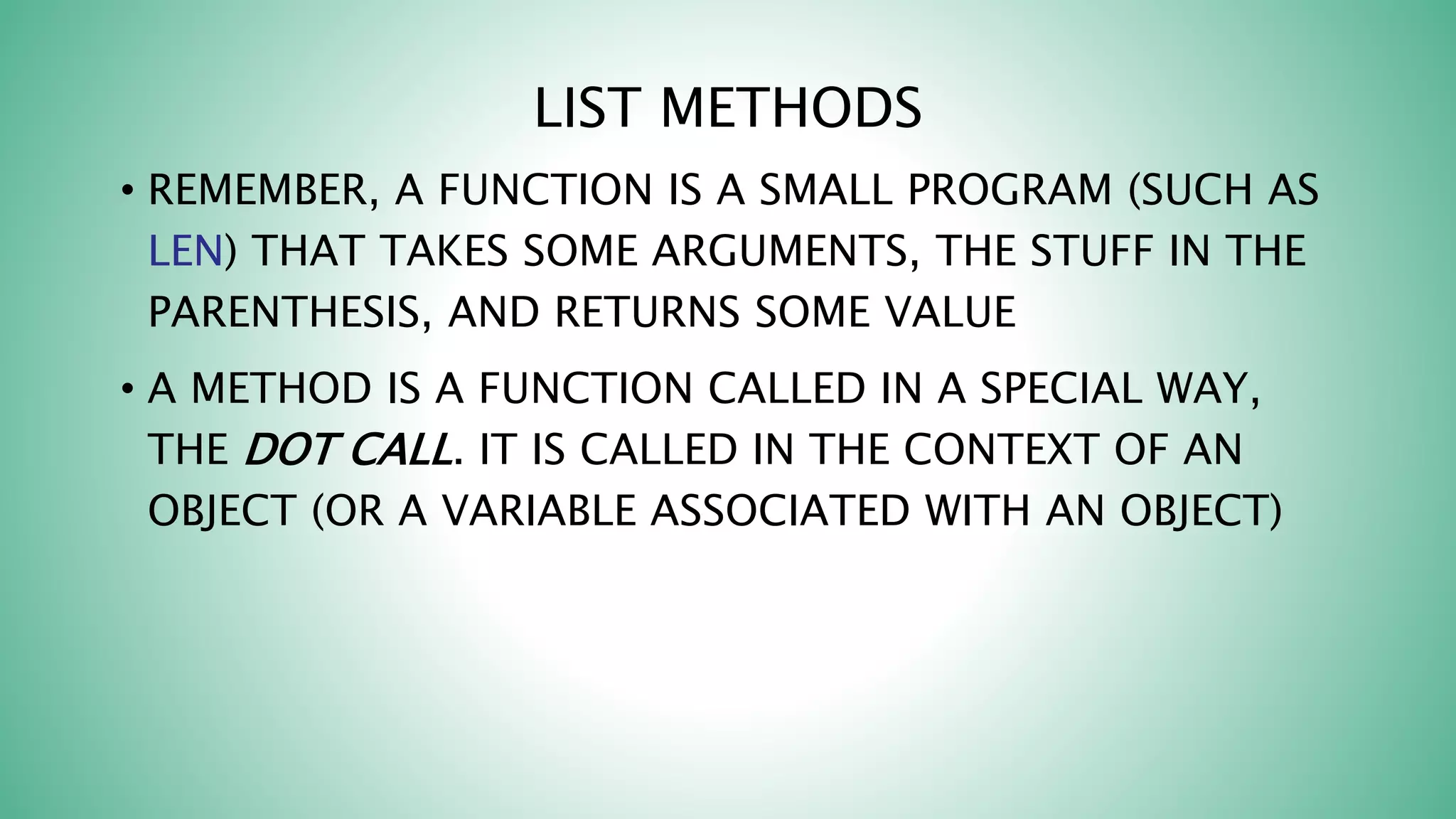
![AGAIN, LISTS HAVE METHODS
MY_LIST = ['A',1,TRUE]
MY_LIST.APPEND('Z')
the object that
we are calling the
method with
the name of
the method
arguments to
the method](https://image.slidesharecdn.com/chapter7-210613212916/75/Lists-and-Tuples-14-2048.jpg)
![SOME NEW METHODS
• A LIST IS MUTABLE AND CAN CHANGE:
• MY_LIST[0]='A' #INDEX ASSIGNMENT
• MY_LIST.APPEND()
• MY_LIST.EXTEND()
• MY_LIST.POP()
• MY_LIST.INSERT()
• MY_LIST.REMOVE()
• MY_LIST.SORT()
• MY_LIST.REVERSE()](https://image.slidesharecdn.com/chapter7-210613212916/75/Lists-and-Tuples-15-2048.jpg)
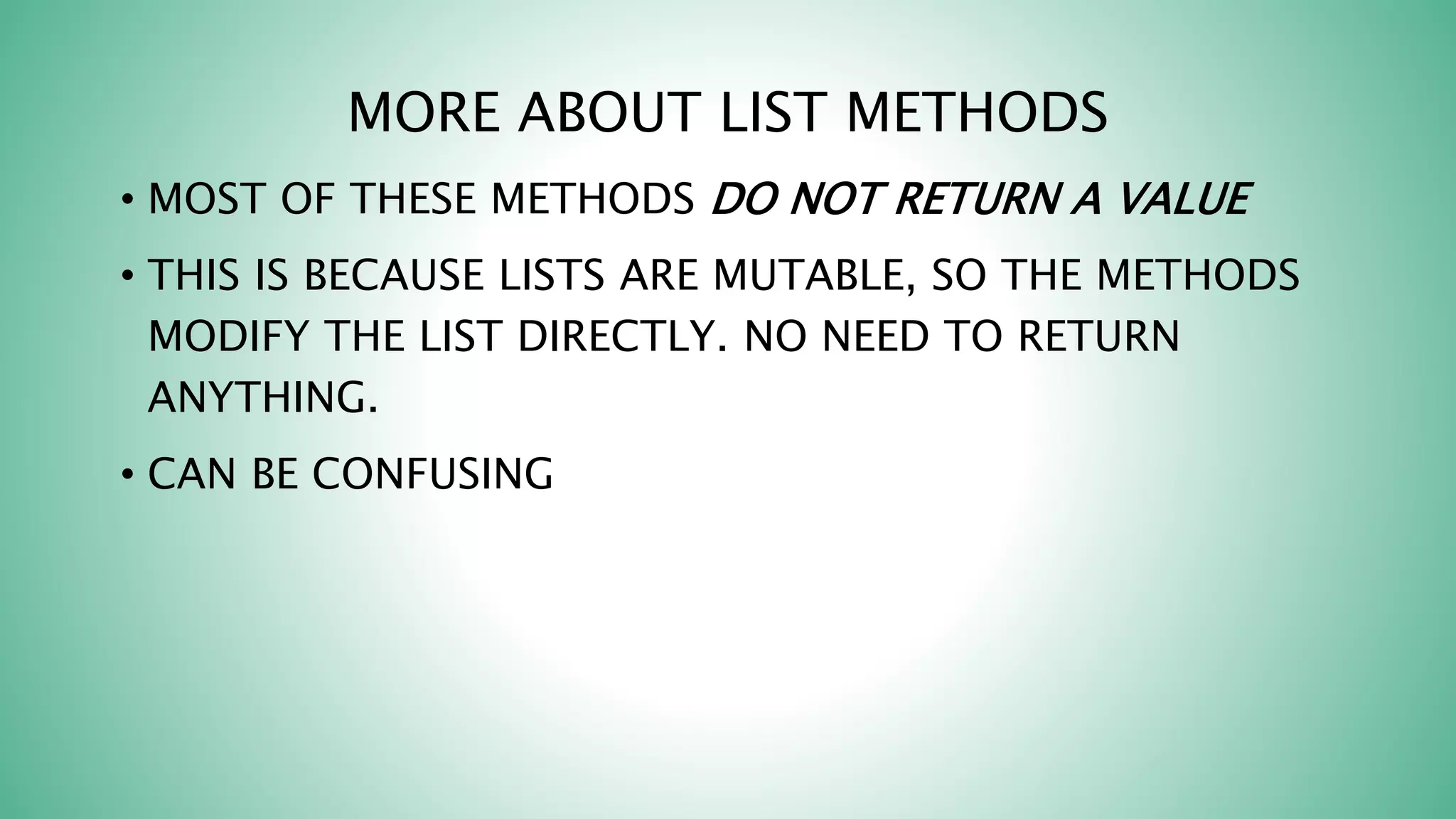
![UNUSUAL RESULTS
MY_LIST = [4, 7, 1, 2]
MY_LIST = MY_LIST.SORT()
MY_LIST NONE # WHAT HAPPENED?
WHAT HAPPENED DID THE SORT OPERATION CHANGED THE
ORDER OF THE LIST IN PLACE (RIGHT SIDE OF ASSIGNMENT).
THEN THE SORT METHOD RETURNED NONE, WHICH WAS
ASSIGNED TO THE VARIABLE. THE LIST WAS LOST AND NONE IS
NOW THE VALUE OF THE VARIABLE.](https://image.slidesharecdn.com/chapter7-210613212916/75/Lists-and-Tuples-17-2048.jpg)
![RANGE
• WE HAVE SEEN THE RANGE FUNCTION BEFORE. IT
GENERATES A SEQUENCE OF INTEGERS.
• IN FACT WHAT IT GENERATES IS A LIST WITH THAT
SEQUENCE:
MYLIST = RANGE(1,5)
MYLIST IS [1,2,3,4]](https://image.slidesharecdn.com/chapter7-210613212916/75/Lists-and-Tuples-18-2048.jpg)
![SPLIT
• THE STRING METHOD SPLIT GENERATES A SEQUENCE OF
CHARACTERS BY SPLITTING THE STRING AT CERTAIN SPLIT-
CHARACTERS.
• IT RETURNS A LIST (WE DIDN'T MENTION THAT BEFORE)
SPLIT_LIST = 'THIS IS A TEST'.SPLIT()
SPLIT_LIST
['THIS', 'IS', 'A', 'TEST']](https://image.slidesharecdn.com/chapter7-210613212916/75/Lists-and-Tuples-19-2048.jpg)
![SORTING
ONLY LISTS HAVE A BUILT IN SORTING METHOD. THUS YOU OFTEN CONVERT YOUR
DATA TO A LIST IF IT NEEDS SORTING
MY_LIST = LIST('XYZABC')
MY_LIST ['X','Y','Z','A','B','C']
MY_LIST.SORT() # NO RETURN
MY_LIST
['A', 'B', 'C', 'X', 'Y', 'Z']](https://image.slidesharecdn.com/chapter7-210613212916/75/Lists-and-Tuples-20-2048.jpg)
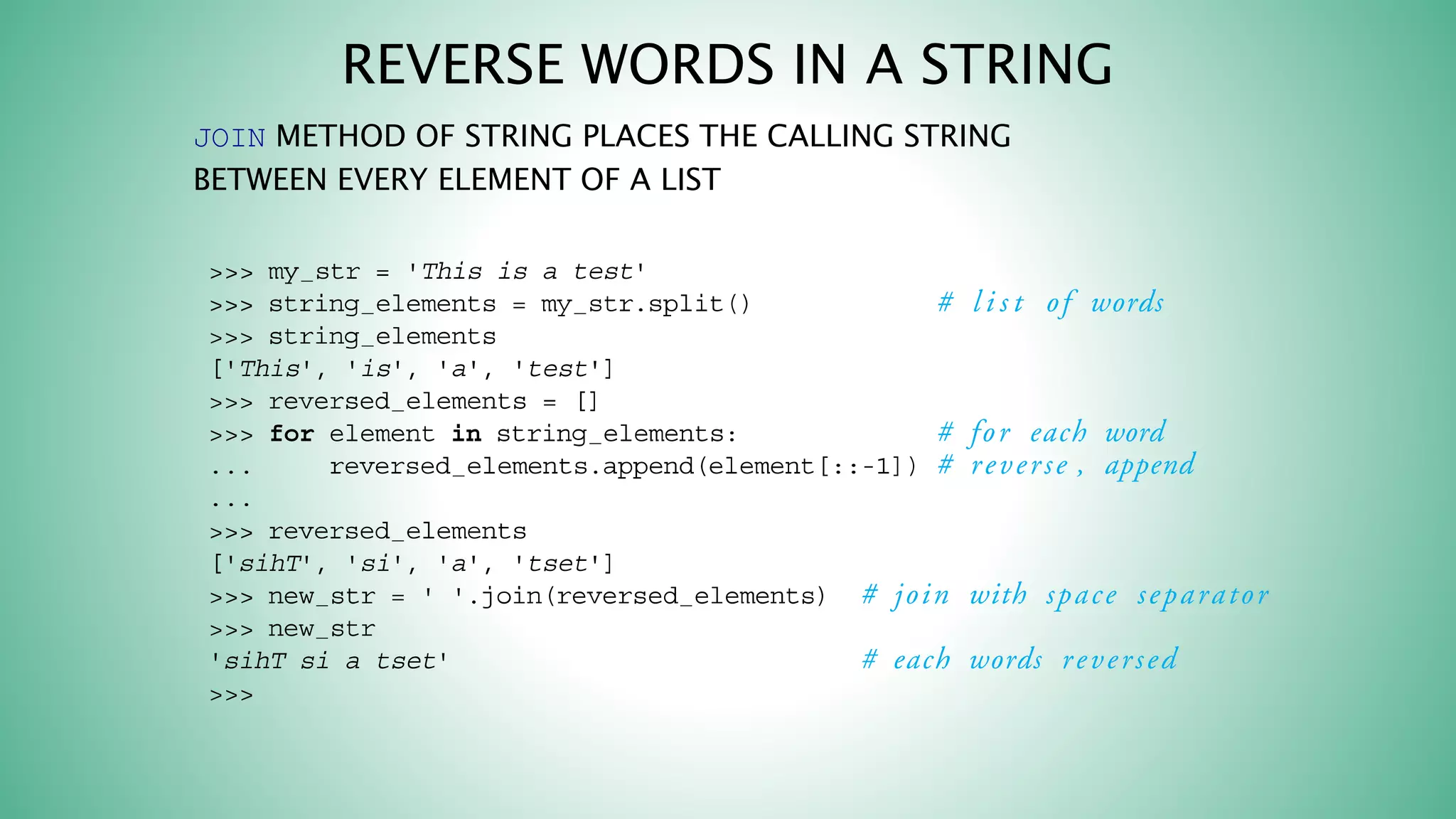
![SORTED FUNCTION
THE SORTED FUNCTION WILL BREAK A SEQUENCE INTO
ELEMENTS AND SORT THE SEQUENCE, PLACING THE RESULTS
IN A LIST
SORT_LIST = SORTED('HI MOM')
SORT_LIST
[‘ ’,'H','I','M','M','O']](https://image.slidesharecdn.com/chapter7-210613212916/75/Lists-and-Tuples-22-2048.jpg)
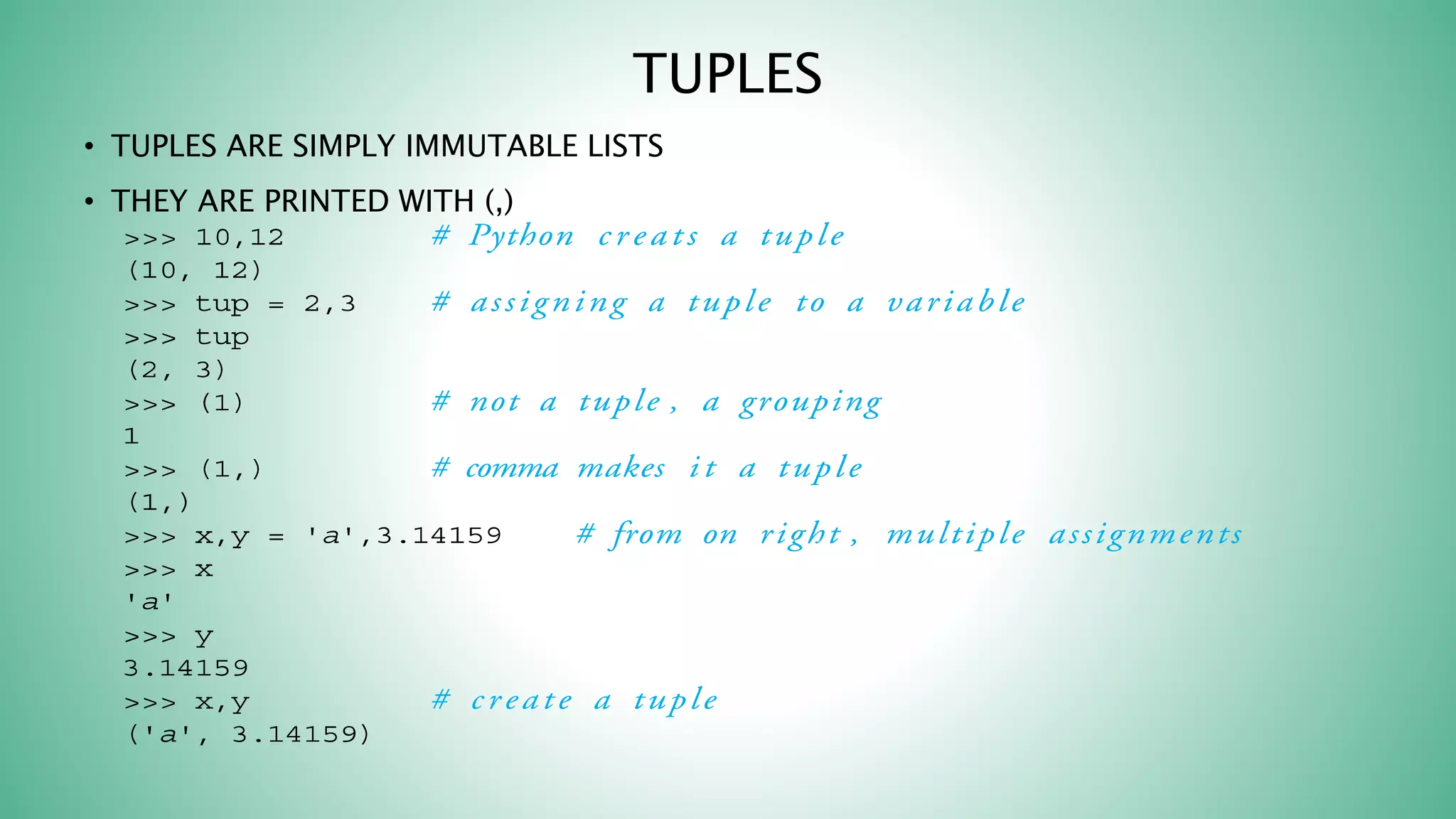
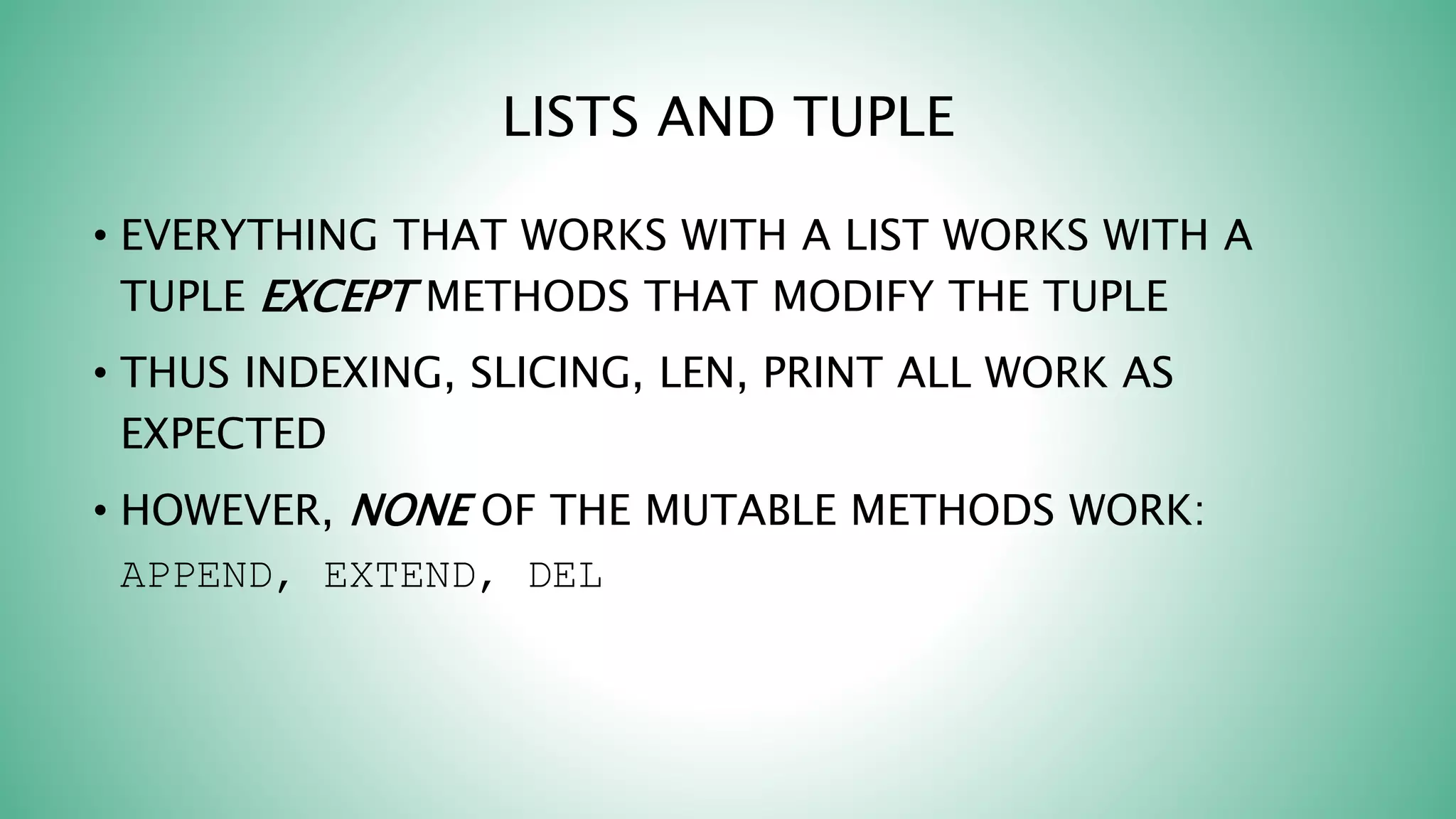

![MULTIPLE COLLECTS
[X+Y FOR X IN RANGE(1,4) FOR Y IN RANGE (1,4)]
IT IS AS IF WE HAD DONE THE FOLLOWING:
MY_LIST = [ ]
FOR X IN RANGE (1,4):
FOR Y IN RANGE (1,4):
MY_LIST.APPEND(X+Y)
[2,3,4,3,4,5,4,5,6]](https://image.slidesharecdn.com/chapter7-210613212916/75/Lists-and-Tuples-26-2048.jpg)